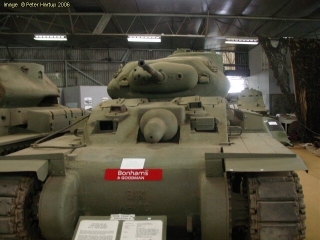Location: Melbourne Tank Museum, Narre Warren North, VIC, Australia
Date: April 2006
This series of images was taken in April 2006 at the Melbourne Tank Museum Auction, Melbourne Australia. The lighting conditions weren’t the best, so let me apologise in advance. But the images are still useful reference.The story of the Australian Cruiser Marks 1 to 4 is one that deserves to be told fully. Conceived at a time when Australia was geographically isolated, it’s traditional ally Britain fighting for it’s own survival, the AC1 (or Sentinel as it came to be known) was Australia’s solution to a dangerous lack (read absence) of modern armour suitable for meeting its commitments overseas (primarily the Middle East at the time) and at home.
Australia had traditionally looked to the UK for its materiel requirements, with local manufacture of small arms, light armoured vehicles and some artillery to British designs supplementing this source after the commencement of war. However, after the disaster of May 1940 in France the entire capacity of British industry was given over to meeting British requirements in staving off an invasion and in holding the Middle East. Likewise, US productive capacity was concentrated on the massive and rapid build-up of its own armoured divisions, including introducing the interim M3 Medium design into service while simultaneously bringing the successor M4 Medium into full production.
The conclusion was quickly reached that if Australia was going to acquire any cruiser class tanks (with operation in the Middle East in mind), it would need to produce the vehicles locally. This was quite a call, considering the state of Australian industry at the outset of the war, particularly in the automotive field – we hadn’t to that point produced so much as a car let alone a modern tank from scratch. Much expert opinion both locally and overseas was skeptical if not outright hostile.
But the programme was started, and many problems were overcome, often producing unique, world-first solutions:
- No capacity to produce thick rolled armour plate? No problem, we’ll fabricate it from four cast components (main body, nose section, engine compartment cover plate and turret) and bolt them together! Major armour castings of this type hadn’t been done before anywhere – and wasn’t really attempted again until the US used similar cast hull designs in the M48 many years later.
- Lack of suitable alloying material to produce armour? No problem, we’ll formulate a new armour alloy which uses only locally available metals and which is the equal to anything we might otherwise acquire. And remember, at this time we didn’t really understand the range and amount of mineral riches this continent possesses.
- No suitable tank engines? No problem, we’ll combine three commercial car engines into a power unit and run it that way.
- No suitable gearbox and final drive? Well, we’ll import the one being used by the US in the new M3 Medium. Oh, the Americans can’t spare any? We’ll build them ourselves from the plans. Errr, the gearing is too complex? Oh well, we’ll design a simplified version which we can manufacture.
- Can’t get hold of suspension bogie units from the Yanks either? No worries, we’ll copy the HVSS system used in French tanks, and it’ll give a superior ride anyway.
- Tracks? We’ll use American double sided rubber block tracks until we get our own steel linked design into production using another locally produced alloy.
- Armament? Let’s start with the British 2 Pdr we’re producing locally, but design in the capacity to take the 6 Pdr if needed (AC1). A bit light on? Let’s leapfrog over the 6 Pdr and go straight to a modified 25 Pdr for that extra punch (AC3). Still not enough? Oh well, we’ll just mount a 17 Pdr and have done with it (AC4)! Naturally all of this upgrading of main armament should be accomplished within basically the same hull – something else no one else managed to do at the time. The only hull modification required was a slight widening of the turret ring (but within the overall hull width) when upgrading from the 2 Pdr to the 25 Pdr, and elimination of the hull machine gun which enabled improved ballistic shaping of the glacis and stowage of the larger ammunition.
So, you get the idea.
With the growing availability of US and British tanks (hand-me-down M3 Mediums and Matildas mainly), and the passing of the threat of Japanese invasion of the Australian mainland the Sentinel programme was cancelled in July 1943 with relatively few examples produced. The Sentinel never saw active service, but soldiered on as a training vehicle until the 1950s.
The first production model of the AC1 was delivered in August 1942, 11 months after the go-ahead was given and 22 months after the Australian General Staff requirement was specified. This must also be some sort of record.
The remaining Sentinels are monuments to a time when Australia made things, and wasn’t afraid to have a go. In any other country the people responsible would be revered and showered with honours. It is interesting to consider whether we could do the same today!





















